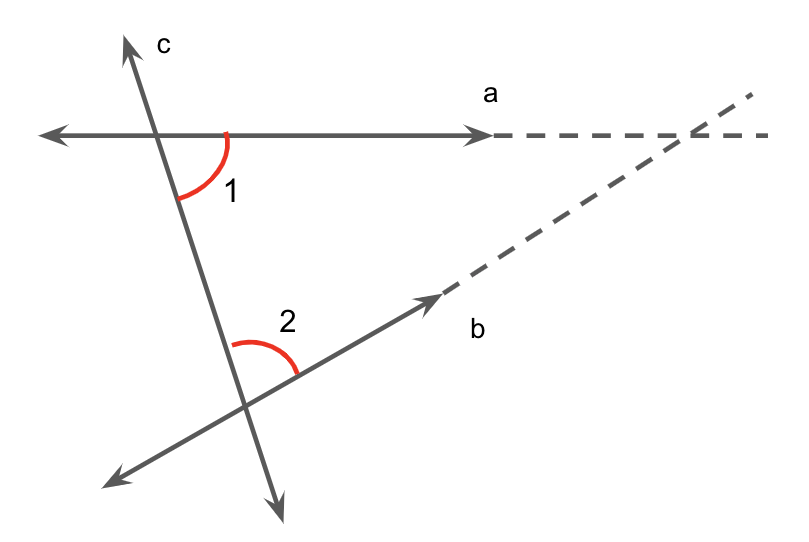
Does Euclid’s fifth postulate imply the existence of parallel lines? Explain.
Answer
576.3k+ views
Hint: Here, we will first use that the Euclid’s fifth postulate is if a straight line falling on two straight lines makes the interior angles on the same side of it taken together less than two right angles, then the two straight lines, if produced indefinitely, meet on that side on which the sum of angles is less than two right angles and then prove it by using the graph and angles.
Complete step-by-step answer:
We know that the Euclid’s fifth postulate is if a straight line falling on two straight lines makes the interior angles on the same side of it taken together less than two right angles, then the two straight lines, if produced indefinitely, meet on that side on which the sum of angles is less than two right angles.
It says that if \[\angle 1 + \angle 2 < 180^\circ \], the line \[a\] and \[b\] meet on the right side of line \[c\].


Therefore, by Euclid’s fifth postulate, line \[a\] and \[b\] will not meet on the right side of \[c\] as sum is not less than \[180^\circ \] as sum is not less than 180 degrees.
Similarly, we have \[\angle 3 + \angle 4 = 180^\circ \].
Hence, by Euclid’s fifth postulate, line \[a\] and \[b\] will not meet on the left side of \[c\] as sum is not less than \[180^\circ \] as sum is not less than 180 degrees.
Thus, Euclid’s postulate implies the existence of parallel lines.
Note: While solving these types of questions, students should know that a statement is an axiom, which is taken to be true without proof and postulates are the basic structure from which lemmas and theorems are derived. We need to know about the Euclid’s postulates before finding the solution of the problem.
Complete step-by-step answer:
We know that the Euclid’s fifth postulate is if a straight line falling on two straight lines makes the interior angles on the same side of it taken together less than two right angles, then the two straight lines, if produced indefinitely, meet on that side on which the sum of angles is less than two right angles.
It says that if \[\angle 1 + \angle 2 < 180^\circ \], the line \[a\] and \[b\] meet on the right side of line \[c\].

Now since we know that \[a\] and \[b\] are parallel, then \[\angle 1 + \angle 2 = 180^\circ \], we have

Therefore, by Euclid’s fifth postulate, line \[a\] and \[b\] will not meet on the right side of \[c\] as sum is not less than \[180^\circ \] as sum is not less than 180 degrees.
Similarly, we have \[\angle 3 + \angle 4 = 180^\circ \].
Hence, by Euclid’s fifth postulate, line \[a\] and \[b\] will not meet on the left side of \[c\] as sum is not less than \[180^\circ \] as sum is not less than 180 degrees.
Thus, Euclid’s postulate implies the existence of parallel lines.
Note: While solving these types of questions, students should know that a statement is an axiom, which is taken to be true without proof and postulates are the basic structure from which lemmas and theorems are derived. We need to know about the Euclid’s postulates before finding the solution of the problem.
Recently Updated Pages
Two men on either side of the cliff 90m height observe class 10 maths CBSE

What happens to glucose which enters nephron along class 10 biology CBSE

Cutting of the Chinese melon means A The business and class 10 social science CBSE

Write a dialogue with at least ten utterances between class 10 english CBSE

Show an aquatic food chain using the following organisms class 10 biology CBSE

A circle is inscribed in an equilateral triangle and class 10 maths CBSE

Trending doubts
Why is there a time difference of about 5 hours between class 10 social science CBSE

Write a letter to the principal requesting him to grant class 10 english CBSE

What is the median of the first 10 natural numbers class 10 maths CBSE

The Equation xxx + 2 is Satisfied when x is Equal to Class 10 Maths

Which of the following does not have a fundamental class 10 physics CBSE

State and prove converse of BPT Basic Proportionality class 10 maths CBSE




